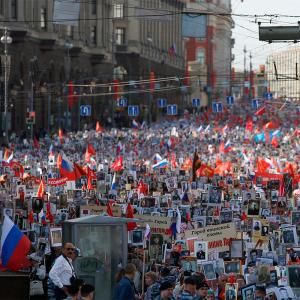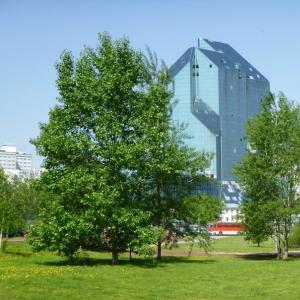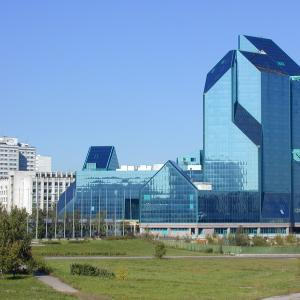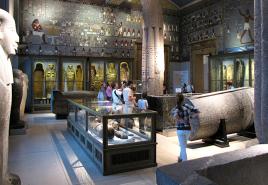What could be the lesson about the British capital? Topic in English "London and its attractions" (London and its attractions).
London draws people from all over the world. Some come on business, some come to study, to work or on holiday. London is naturally a very English city and it is very cosmopolitan, containing goods, food and entertainment, as well as people, from many countries of the world.
London spreads its influence over much of the southern areas of England; it gives work to millions of people who live not only in the inner city areas but in surrounding districts.
There is much in London which fascinates visitors and inspires the affection of Londoners: the splendor of the royal palaces and the Houses of Parliament, the dignity of St. Paul "s Cathedral and many monuments and beautiful parks.
London shows examples of buildings that express all the different areas of its history.
Buckingham Palace is the official London residence of the Sovereign. The daily ceremony of the Changing of the Guards takes place in its courtyard. The palace was built in 1703 by the Duke of Buckingham.
Piccadilly Circus has become an important meeting point - for as well as sightseers. At its heart is a bronze fountain topped by a figure of a winded archer, known as Eros, the pagan god of love.
This area is now famous for its theaters, clubs and shops.
Whitehall is a street in central London running from Trafalgar Square to the Houses of Parliament and containing many important buildings and government offices, such as the Treasury, Admiralty and others. In the center of the roadway stands the Cenotaph, the memorial to the fallen of both world wars. The Prime Minister "s residence at No. 10 Downing Street is directly connected to Whitehall.
London is always full of life. The streets are crowded with traffic. High "double-decker" buses rise above the smaller cars and vans.
The city of London today is the financial powerhouse of the country and one of the chief commercial centers of the western world.
The city has its own Lord Major, its own Government and its own police force. Here the medieval buildings stand side by side with modern glass high-rise offices.
The parks of London provide a welcome contrast to the great built-up areas. St. James "s Park, Green Park, Hyde Park, and Kensington Gardens are linked together. They form 313 hectares of open parkland in the heart of London.
Transfer:
London attracts people from all over the world. Some come on business, some to study, work or on vacation. London is naturally a typical English city, very cosmopolitan, containing goods, food and entertainment, as well as people from many countries of the world.
London spreads its influence over most of the southern regions of England, it employs millions of people who live not only in urban areas, but also in the surrounding areas.
There are many things in London that enchant visitors and inspire the love of Londoners: the splendor of the Royal Palace and the Houses of Parliament, the grandeur of St Paul's Cathedral and many monuments, beautiful parks.
London shows examples of buildings that reflect different areas of its history.
Buckingham Palace is the official London residence of the monarch. Daily changing of the guard ceremonies take place in its courtyard. The palace was built in 1703 by the Duke of Buckingham.
The Piccadilly Circus has become an important meeting point as well as a landmark. It is based on a bronze fountain crowned with the figure of an archer known as Eros, the pagan god of love.
This area is now known for its theaters, clubs and shops.
Whitehall is a street in central London that runs from Trafalgar Square to the Houses of Parliament and contains many important buildings and government agenciessuch as Treasury, Admiralty and others. In the center of the roadway stands the Cenotaph - a memorial to those who fell in both world wars. The Prime Minister's residence at 10 Downing Street is directly linked to Whitehall.
London is always full of life. The streets are full of traffic. Spiritual decker buses rise above small cars and minibuses. The city of London is today the country's financial center and one of the major shopping centers in the Western world.
The city has its own head - the mayor, its own government and its own police service.
Here, medieval buildings stand side by side with the modern glass of high-rise offices. London's parks contrast well with the vast built-up areas. St James's Park, Green Park, Hyde Park, and Kensington Gardens are all linked together. They comprise 313 hectares of open park in central London.
London Attractions - sights London
London "s most famous places of interest
Buckingham PalaceBuckingham Palace is the official residence of Queen Elizabeth. It is located near Green Park. When the Queen is in the residence, the Royal Standard flies over Buckingham Palace.
There are 775 rooms where members of the Royal family and their servants live. There are also rooms for guests. There are offices, on-site post and even swimming pool in the palace.
Throughout the year right in front of Buckingham Palace the ceremony of the Changing of the Guard takes place, attracting a lot of tourists.
The tower of london

The Tower of London is one of the main London "s places of interest. It is located on the north bank of the River Thames and is one of the oldest buildings.
At different times the Tower was used as a royal residence, fortress, prison, mint and, even, zoo. Today the Tower of London is the place where the Crown Jewels are kept.
Every day its doors are open for tourists. A few black ravens live on its territory. The walls of the Tower are still guarded by palace guard in historical outfits.
Trafalgar Square

Trafalgar Square is located in the center of London. It was named after the victory in the Battle of Trafalgar. In the center of the square there is Nelson "s column with four lions at the bottom of it.
There are beautiful fountains in the square. Some famous buildings, such as the National Gallery, St. Martin-in-the-fields and Admiralty Arch, are also located there.
The square is the place where a lot of different events and celebrations are held.
Hyde park

Hyde Park is a big park located in central London. Today it is a popular place for meetings, celebrations and festivals.
The park is known for its artificial lake Serpentine where it is allowed to swim. There is a gallery, a museum and several sculptures on the territory of Hyde Park.
During the Olympic Games 2012 Hyde Park was the place where some competitions were held.
St. Paul "s Cathedral

St. Paul "s Cathedral is located at the highest point of the City of London, Ludgate Hill. The Cathedral was seriously damaged during the Great Fire of London. It was redesigned by Christopher Wren, a famous architect.
There are three Galleries and 17 bells in the Cathedral. The largest bell is called Great Paul. The funerals of a lot of notable figures have occured at the cathedral.
The British Museum

The British Museum is one of the largest museums in the world. It was founded in the XVIII century and in the XIX century it was already divided into different departments.
The museum houses large collections of artefacts representing different cultures of the world, both ancient and modern.
So, there is the Department of coins and medals, the Department of prints and drawings, the Department of Ancient Egypt and Sudan and many others.
The london eye

The London Eye is one the largest Ferris wheels in Europe. Unforgettable views of the city open from its height of 135 meters.
The wheel consists of 32 air-conditioned capsules which symbolize 32 boroughs of London. The London Eye rotates with the speed of 0.9 km / hour. The ride takes 30 minutes. The wheel looks like a big bicycle wheel.
Oxford Street

Oxford Street is a lively shopping street located in the center of London. There are hundreds of shops in this street. The street is 1.9 km long. It is one of the busiest commercial streets in Europe.
During Christmas time Oxford Street is decorated with lots of lights and garlands making it one of the most popular destinations for tourists.
Westminster

Westminster is a historical area of \u200b\u200bcentral London with several famous landmarks.
Westminster Abbey, a Gothic church, is located there. The church is a traditional place of coronation and burial site for all British kings and queens.
Not far from the church there is the Palace of Westminster which is the meeting place of the House of Commons and the House of Lords.
Big ben

Big Ben is the name of the Great bell of the clock at the Palace of Westminster. Nowadays this name mostly refers to the clock and the clock tower.
In 2012 the tower was renamed to celebrate the Diamond Jubilee of the Queen and is now officially known as the Elizabeth Tower.
The height of the tower is 96.3 meters. Big Ben is one of the most prominent symbols of the United Kingdom.
The most famous landmarks in London
Buckingham PalaceBuckingham Palace is the official residence of Queen Elizabeth. It is next to Green Park. When the queen is inside, the royal standard flies over Buckingham Palace.
It has 775 rooms where members of the royal family and their servants live. There are also guest rooms. The palace has offices, an internal post office and even a swimming pool.
Throughout the year, a changing of the guard ceremony takes place in front of Buckingham Palace, attracting many tourists.
Tower of London
The Tower of London is one of the main attractions in London. It is located on the north bank of the Thames and is one of the oldest buildings.
At various times, the Tower was used as the residence of kings, a fortress, a prison, a mint and even a zoo. Today, the Tower of London is the place where royal jewels are kept.
Its doors are open to tourists every day. Several black ravens live on its territory. The walls of the Tower are still guarded by royal guards in historical costumes.
Trafalgar Square

Trafalgar Square is located in the center of London. It was named after the victory in the Battle of Trafalgar. In the center of the square stands a monument to Admiral Nelson with 4 lions at its base.
There are beautiful fountains in the square. Some notable buildings such as the National Gallery, St. Martin in the Fields and the Admiralty Arch are also located here.
The square is home to numerous events and celebrations.
Hyde Park

Hyde Park is a large park located in the center of London. Today it is a popular place for meetings, celebrations and festivals.
The park is famous for its artificial lake Serpentine, which is allowed to swim. On the territory of Hyde Park there is a gallery, a museum and several sculptures.
During the 2012 Olympics, Hyde Park became the site of several competitions.
St Paul's Cathedral

St Paul's Cathedral is at the highest point in London, Ludgate Hill. During the Great Fire in London, the cathedral was badly damaged. It was remodeled by Christopher Wren, a renowned architect.
It has 3 galleries and 17 bells. The largest bell is called Big Paul. The funerals of many famous personalities were held in the cathedral.
British museum

The British Museum is one of the largest museums in the world. It was founded in the 18th century, and in the 19th century it was already divided into different departments.
The museum contains extensive collections of items representing different cultures of the world - both ancient and modern.
So, there is a numismatic department, a department of engravings and canvases, a department of culture of Ancient Egypt and Sudan, and many others.
London eye

The London Eye is one of the largest Ferris wheels in Europe. An unforgettable view of the city opens up from its height of 135 meters.
The wheel consists of 32 air-conditioned capsules, symbolizing the 32 boroughs of London. The London Eye rotates at 0.9 km / h. The whole trip takes 30 minutes. The wheel looks like a large bicycle wheel.
Oxford Street

Oxford Street is a busy shopping street located in central London. There are hundreds of shops on the street. The street is 1.9 km long. This is one of the busiest shopping streets in Europe.
During Christmas, Oxford Street is decorated with lights and garlands, and the street itself becomes one of the most popular tourist destinations.
Westminster

Westminster - historic district in the center of London, where several famous landmarks are located.
Here is Westminster Abbey - a Gothic church. The church is the traditional coronation and burial place of all British kings and queens.
Not far from the church is Westminster Palace, where the House of Commons and the House of Lords hold their meetings.
Big Ben

Big Ben is the name of the large bell on the clock at Westminster Palace. Today, this name mainly refers to the clock and clock tower.
In 2012, the tower was renamed to commemorate the Queen's Diamond Jubilee and is now officially known as Elizabeth Tower.
The height of the tower is 96.3 meters. Big Ben is one of the most famous symbols of the United Kingdom.
To use the preview of presentations, create yourself a Google account (account) and log into it: https://accounts.google.com
Slide captions:
London Attractions
The symbol and the flag. The United Kingdom of Great Britain and Northern Ireland uses as its national flag known as the Union Flag or Union Jack. The symbol of England is red rose.
Trafalgar Square It is the central square of London and traditional place for people to meet.
The Houses of Parliament It is a place where the British Government sits. It consists of three parts: the Royal Apartments, the House of Lords and the House of Commons.
Big Ben It’s a clock in the tower and it is a big bell. You can hear it every hour. It weighs 13.5 tons.
Tower Bridge It is the oldest and famous bridge across the Thames. It was made of wood by the Romans, but it was often burnt down. Later it was made of stone.
The Tower of London It has a long history. In the past it was a fortress, a prison, a castle and a zoo. It was built to protect the city from the enemies. There are a lot of ravens at this place. Nowadays this building is a very popular museum.
Buckingham Palace It's the London home of the Queen. Buckingham Palace was built between 1702 and 1705. The palace is open to public.
Fish and chips. A dish of deep-fried fish and chunks of French fries.
Oxford Street It is the biggest shopping street in London. There are 548 shops in Oxford Street.
The London Eye It’s the biggest observation wheel in the world. It is situated on the banks of the River Thames in Central London It's height is 135 meters.
Hello my dear readers!
What do modern schoolchildren know about the sights of London? Do they know that the name "Big Ben" is not the name of a clock or a tower at all? This is the name of a huge bell that is located inside the tower itself! And have they heard the story that once, due to a flock of birds, who decided to sit on the clock, time slowed down by 5 minutes?
Today we will form completely new knowledge and talk about the sights of London on english language... We will combine business with pleasure.
I have prepared a text for you, where I will briefly tell you about 10 of the most interesting places in London. Naturally, all this will be in English with pictures, and, so be it, with translation. Get ready to watch the most interesting video where you will learn a lot of new things.
1. The Big Ben.

The world-known clock. Everyday about 500 tourists come to London to see the Big Ben. Built in 1858, it was named after an architect whose name was Ben (Benjamin). The interesting fact is that you are not allowed to get inside the Big Ben if you aren’t an Englishman. No tourists allowed.
2. Madam Tussaud "s Museum

The most famous museum of waxworks. It presents all famous people from singers and actors to Prime Ministers and Presidents. All the waxworks are of such a good quality, that sometimes you can mistake them for a real person.
3. Piccadilly Circus.

The place is far from what is called “a circus”. It is a well-known meeting point of the city. It has become so popular, that is now considered to be a place to visit for all the tourists.
4. London Eye.

It is one of the biggest observation wheels in the world. Its height is 135 meters. It has 32 cabins which symbolize 32 districts of London. It takes 30 minutes to make a full circle. But it is the view you will never forget. The cost is about £ 20.
5. London National Gallery.

The gallery has more than 2000 works of world-known artists of XIII-XX centuries. You can spend the whole day there and it will not be enough. What is interesting, is that the gallery is free for everyone.
6. Parks of London.

London is famous for its parks. Combined, all these parks cover more land than the Principality of Monaco. The most well-known is the Hyde Park. It is a traditional place of festivals and celebrations.
7. St. Paul's Cathedral.

It was built on the highest point of London 300 years ago. It is the London Bishop's residence and is the most popular place of visit. The price of visit is £ 16.
8. The Houses of Parliament.

The official name is Palace of Westminster. It includes more than 1,100 rooms, more than a hundred stairs and about 5 kilometers of corridors. the House of Commons and the House of Lords (two traditional chambers) are located here. Nowadays anyone can visit the Houses of Parliament and even attend the session. You have to register by phone and go through special registration procedure.
9. The Thames.

The longest and most famous river in the UK which the British often call the "Father Thames". In 1894 Tower Bridge was opened, and in 2012 a modern cableway was built over it. Popular tourist activities are river excursions and water-bus or boat trips. Every year one can watch here the boat race between Oxford and Cambridge universities.
10. Nelson's Column.

One of London's most recognizable landmarks which is located in Trafalgar Square. It was built between 1840-1843 to commemorate Admiral Horatio Nelson who died in 1805 at the Battle of Trafalgar. Later, in 1868, the four sitting bronze lions were added to the base of the monument. The column is made of granite. Its weight is around 2,500 tonnes and its height is over 50 meters. In 2006 it was restored.
Do you want to know English better than others? And be able to talk not only about London, but also about many other things? Then register on the LinguaLeo website and learn English fun - with videos, songs, stories and assignments! It's free.
1. "Big Ben"
World famous watches. Every day about 500 tourists come to London to see Big Ben. Built in 1858, it was named after an architect named Ben (Benjamin). Fun fact: you cannot get inside Big Ben unless you are English. Tourists are not allowed.
2. Madame Tussauds Museum.
The most famous wax museum. It features all famous people from singers and actors, to prime ministers and presidents. All works are so well done that sometimes you can confuse them with a real person.
3. Piccadilly Circus.
The place is far from the word "circus" (from English Piccadilly Circus). It is a famous meeting place in the city. The place has become so popular that it is now considered a must-see for tourists.
4. London Ferris wheel.
One of the largest in the world! Its height is 135 meters. It consists of 32 booths that symbolize the 32 boroughs of London. A full circle takes 30 minutes. But this is the kind you will never forget. The cost is around £ 20.
5. London National Gallery.
The gallery contains more than 2000 works of world famous masters of the XIII-XX centuries. You can spend the whole day there and it won't be enough. What's interesting is that admission to the gallery is free for everyone.
6. Parks of London.
London is famous for its parks. If you add up the area of \u200b\u200ball the parks, they will cover more land than the Principality of Monaco. The most famous is Hyde Park. It is a traditional venue for festivals and celebrations.
7. Cathedral of St. Paul.
It was erected at the highest point in London 300 years ago. It is the seat of the Bishop of London and is a popular place to visit. Entrance fee £ 16.
8. Parliament building.
The official name is Westminster Palace. It includes more than 1,100 rooms, more than a hundred stairs and about five kilometers of corridors. There are two traditional chambers here: Lords and Commons. Nowadays, everyone can visit the Parliament building and even attend a meeting of the chambers. To do this, you need to make an appointment by phone and go through a special registration procedure.
9. River Thames.
The longest and most famous river in Great Britain, which is often called "Father Thames" by the British. The Tower Bridge was opened in 1894, and in 2012 a modern cable car was erected over the river. A popular activity of tourists is excursions and walks on river trams and boats. Every year you can watch boat competitions between the universities of Oxford and Cambridge.
10. Nelson's Column.
One of the most recognizable landmarks in London, located in Trafalgar Square. It was built between 1840-1843. in honor of Admiral Horatio Nelson, who died in 1805 in the Battle of Trafalgar. Later, in 1868, four seated bronze lions were added to the base of the monument. The column is made of granite. Its weight is about 2500 tons and its height is over 50 meters. In 2006, the column was restored.
Useful expressions:
the world-known clock - world famous watches
t o be named after - be named after
to allow to do sth - allow to do something
to famous represent people -represent famous people
of a good quality -good quality
mistake smb for smb - confuse someone with someone
to be free -bbe free
to be famous for sth - to be known for something
be located - to be located, to be
cableway - cable car
landmark - Sight.
Now let's add to this an exciting video about London. Listen, watch, marvel, learn and practice English at the same time!
Well, I think that now English lessons for the 5th grade (and maybe 6th grade!) Will only be a joy, and writing or related to the sights of London will be a pleasure, because now you know everything!
I will be glad to see you among the readers of my blog and share with you all the most interesting.
Sightseeing in London
London is one of the most interesting cities in Europe. You can start your sightseeing tour from the City where some famous ancient buildings are situated. Perhaps the most striking of them is St. Paul "s Cathedral, the greatest of English churches. It is Sir Christopher Wren" s masterpiece. It stands at the top of Ludgate Hill on a site where a Christian church had stood since the 7th century. The construction of the Cathedral started in 1675 and was not finished until 1709. The magnificent classical structure is crowned by the dome. The dome is painted with scenes from the life of St. Paul. Here also is the famous Whispering Gallery. There are many memorials in the Cathedral including those to heroes such as Wellington and Nelson.
The Tower of London is also situated in the City. It has been closely associated with many important events in English history. It served as citadel, palace, prison, mint and menagerie. The White Tower was built in 1078 by William the Conqueror to protect the city. The Tower is famous for its illustrious prisoners, such as Sir Thomas More and Guy Fawkes. Many notable people lost their heads on the executioner "s block. The Tower is guarded by the Yeoman Warders popularly known as Beefeaters.
Westminster is the historic and governmental center of London. Until the 11th century it was a sacred place. King Edward the Confessor decided to build a great abbey church here. It was consecrated in 1065, but a week later the King died and was buried in the abbey. His tomb became a popular place of pilgrimage. It can still be found at the heart of the present Westminster Abbey. William the Conqueror was crowned in the Abbey and since then all the Coronations have taken place here. The Abbey contains many royal tombs, memorials to eminent men and women. But the most popular ones are those to writers, actors and musicians in Poet "s corner.
Alongside the Abbey Edward the Confessor had a palace built. The Palace of Westminster was the royal residence and also the country "s main court of law. Parliament met here from the 16th century until the 19th century. The present Houses of Parliament were built after the old palace was burnt down in 1834. The building contains the House of Commons and the House of Lords, the two chambers where parliamentary business is debated.
On the corner next to Westminster Bridge stands the Clock Tower, which houses the famous bell Big Ben.
Buckingham Palace is the Queen "s official London residence. Built in 1702-1705 for the Duke of Buckingham, it was sold in 1761 to George III. The Palace was little used by royalty until Victoria" s accession to the throne in 1837. London "s most popular spectacle is Changing of the Guard at Buckingham Palace. It takes place in the forecourt and lasts about 30 minutes.
Going down Oxford Street you come to Trafalgar Square which is yet another symbol of London. This square received its name from Trafalgar, the cape off which Lord Nelson defeated a Franco-Spanish fleet in 1805. Admiral Nelson, cast in bronze, stands on top of a tall column in the middle of the square.
On the north side of Trafalgar Square is the National Gallery and the National Portrait Gallery. Not far away is the British Museum - the biggest museum in London. It contains a priceless collection of ancient manuscripts, coins, sculptures etc., and is famous for its library.
London Attractions
London is one of the most interesting cities in Europe. You can start your sightseeing in the City, where some of the famous old buildings are located. Perhaps the most striking of these is St. Paul's Cathedral, the greatest of all English churches. This is a masterpiece by Sir Christopher Wren. It stands at the top of Ludgate Hill, where a Christian church has stood since the 7th century. The construction of the cathedral began in 1675 and was completed only in 1709. The magnificent classical structure is crowned with a dome. Inside, the dome is painted with scenes from the life of St. Paul. It also houses the famous Whisper Gallery. The cathedral has many monuments, including heroes such as Wellington and Nelson.
The Tower of London is also located in the City. It is closely associated with many important events in English history. The Tower was a fortress, palace, prison, mint and menagerie. The White Tower (White Tower) was built in 1078 by William the Conqueror to defend the city. The Tower is known for its famous prisoners such as Sir Thomas More and Guy Fawkes. Many outstanding people laid their heads here on the chopping block. The Tower is guarded by Life Guards (iomen guards), who are usually called beefeaters (meat eaters).
Westminster is the historical and governmental part of London. Until the 11th century, it was a sacred place. King Edward the Confessor decided to build a large abbey with a church here. It was consecrated in 1065, but a week later the king died and was buried in the abbey. His grave became a popular pilgrimage site. It can still be found in the center of what is now Westminster Abbey. William the Conqueror was crowned at the abbey, and since then all coronations have taken place here. The abbey contains the tombs of many kings and monuments to outstanding people. But the most popular are the monuments to writers, actors and musicians in the Poet's Corner.
Edward the Confessor built a palace near the abbey. Westminster Palace was the royal residence as well as the country's main court. From the 16th to the 19th century, the parliament gathered here. The current parliament building was built after the old palace burned down in 1834. The building houses the House of Commons and the House of Lords, two chambers that discuss parliamentary affairs.
At the corner of Westminster Bridge is the Clock Tower, which houses the famous Big Ben Bell.
Buckingham Palace is the Queen's official residence in London. It was built in 1702-1705 for the Duke of Buckingham, and in 1764 it was sold to George III. The royal family made little use of the palace until Victoria's accession to the throne in 1837. The most popular sight in London is the changing of the guard at Buckingham Palace. It takes place in front of the palace and lasts about 30 minutes.
Walking down Oxford Street, you come to Trafalgar Square, another symbol of London. The area was named after Cape Trafalgar, where Lord Nelson defeated the Franco-Spanish fleet in 1805. Bronze Admiral Nelson stands on top of a tall column in the center of the square.
On the north side of Trafalgar Square are the National Gallery and the National Portrait Gallery. Not far from here is the British Museum, the largest museum in London. It contains an invaluable collection of ancient manuscripts, coins, sculptures, etc., and is famous for its library.
Vocabulary:
Changing of the Guard - changing of the guard
the City - City, downtown London
coin - coin
to be consecrated - to be consecrated
to crown - to crown
defeat - win
dome - dome
Edward the Confessor - Edward the Confessor, King of England (1042- |
fleet - fleet
in memory of- in memory of
luxury - luxury
medieval - medieval
menagerie - menagerie
mint - mint
pilgrimage - pilgrimage
priceless - priceless
sacred - sacred
splendid - great
the Stock Exchange - London Stock Exchange
striking - striking, wonderful
the Stuarts - Stuarts
Thomas More - Thomas More (English thinker, writer)
tomb - grave
the Tudors - Tudors
Whispering Gallery - Whisper Gallery
William the Conqueror - William the Conqueror, William I (1066-1087) (first Norman king in England)
to win the right - get the right, get the right
workshop - workshop
Yeoman Warder - Tower Guard, Life Guard
Answer the questions
1. What famous buildings do you know within the city?
2. What places of interest are there in St. Paul "s Cathedral?
3. What was the Tower used for?
4. Who built the abbey and the palace in Westminster?
5. Where does the Parliament meet?
6. What is Buckingham Palace famous for?
7. Where is London "s most famous shopping area situated?
8. Why did Trafalgar Square receive this name?
9. What London museums do you know? What are they famous for?
10. Explain how these dates are connected to the city history: 1078,1675, 1805, 1761, 1834, 1709?







